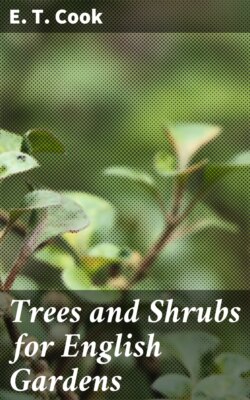Читать книгу Trees and Shrubs for English Gardens - E. T. Cook - Страница 17
На сайте Литреса книга снята с продажи.
Increasing Hardy Shrubs
ОглавлениеTable of Contents
The best of our hardy flowering shrubs are grouped under seven natural orders, and a knowledge of the order to which a plant belongs is in most cases a guide to its propagation, as the majority of the species contained in an order are, as a rule, increased by the same methods.
Berberideæ.—This contains Akebia and Berberis, which are propagated by seeds, cuttings, or layers. Berberis stenophylla and B. Neuberti do not come true from seed, so that one or both of the other methods mentioned above must be adopted.
Leguminosæ.—In this order such genera as Cytisus (Broom), Genista (Rock Broom), Spartium (Spanish Broom), Ononis, Indigofera, Colutea (Bladder Senna), Caragana (Siberian Pea tree), and Cercis (Judas tree) should be raised from seed, which is the quickest and best method of propagation. Cuttings of certain forms of Cytisus and Genista will root readily, but the plants will sometimes die off just as they have attained flowering size. Ulex (Furze, Whin, or Gorse) is propagated by seeds or cuttings, and Wistarias by seeds or by layering.
Rosaceæ.—This includes Prunus, the shrubby forms of which can, in the majority of cases, be increased by cuttings or layers; Spiræa and Kerria (Jews' Mallow), cuttings of which root readily at almost any time of the year; Exochorda (Pearl Bush), must be raised from seed to do any good; Rubus (Brambles), some of which can be propagated by suckers, and the remainder by pegging the points of the shoots down to form young plants; Rosa (Rose), the species of which should be increased by seeds, cuttings, or layers, though seeds will not always come true, as Roses become hybridised very readily; and Cotoneaster, which are increased by seeds, cuttings, or layers.
Saxifrageæ.—In this order Hydrangea, Deutzia, Philadelphus (Mock Orange), Escallonia, and Ribes (Flowering Currant) are included. All are easily propagated by cuttings taken in almost any season of the year. With the exception of Hydrangea, which should be struck under glass, all the members of this order root readily outdoors in the winter.
Caprifoliaceæ.—This order contains such genera as Sambucus (Elder), Viburnum, Lonicera (Honeysuckle), Symphoricarpus (Snowberry tree), Abelia, Leycesteria, and Diervilla (Weigela). All are easily propagated by cuttings or by layering. The cuttings can be taken at almost any time of the year, and root quickly, the young plants attaining a good size by the end of the second year.
Ericaceæ.—This order includes all the so-called American plants, such as Pernettya, Gaultheria, Leucothoë, Andromeda, Pieris, Zenobia, Erica (Heath), Calluna (Common Heather, Ling), Kalmia, Ledum, Clethra, and Rhododendron (including Azalea). These can all be increased by seeds, layering, and, in addition, the first two by division of the old plants. Erica and Calluna can also be increased by cuttings. Seedlings, of course, make the best plants, but layering is a quicker method, and, in the case of some of the smaller Ericaceæ, one of the easiest. All the Rhododendrons will not root from cuttings, though some of the small-flowered ones strike easily, but practically all may be increased from layers. A few of the showy garden forms cannot be raised from layers, and have to be grafted on stocks of the common R. ponticum or R. catawbiense.
Oleaceæ.—This includes both deciduous flowering shrubs and ornamental evergreens, such as Syringa (Lilac), Chionanthus (Fringe tree), Jasminum (Jasmine), Forsythia, Ligustrum (Privet), Phillyræa (P. decora (vilmoriniana) is so easily raised from seeds or cuttings that it is foolish to graft it on the common privet), and Osmanthus being represented. The first two are best propagated by seeds or layers, though the named garden Lilac is usually grafted on stocks of the common S. vulgaris, a silly practice. It is a pitiful business keeping down suckers from grafted plants. Ask for Lilacs on their own roots, and much vexation will be saved. A garden should be a place of rest and pleasure, not a hunting-ground for suckers. The other genera are readily raised by cuttings taken at almost any time of the year, or by layering.
Although the above orders include a considerable number of our best shrubs, several plants must be specially mentioned. The Clematis is increased by seeds, cuttings, or layers in the case of the species, but unfortunately the garden forms are usually grafted on C. Viticella or C. Flammula, whereas many can be propagated by cuttings, and practically all will root when layered.
TULIP TREE AT RANELAGH (Winter).
In the absence of seeds the following genera must be propagated by layers, viz., Aucuba, Chimonanthus (Winter Sweet), Halesia (Snowdrop tree), Hamamelis (Witch Hazel), Hippophaë (Sea Buckthorn), and Myrica (Candleberry Myrtle). Cuttings of the first will root readily enough, but never seem to succeed afterwards. The female form of Hippophaë is best raised from layers, as seedlings usually give a large percentage of male plants. Aralia and Rhus (Sumach) are increased by seeds or root-cuttings; Buddleia japonica is best raised from seeds, and the other Buddleias from cuttings; and practically all other hardy shrubs that have not been specially mentioned are easily propagated by seeds, cuttings, or layers, and the majority of them by all three methods.
If it is impossible to increase a tree or shrub by any other means than by the three methods mentioned, then resort to budding or grafting.
WINTER BEAUTY OF LIME.
